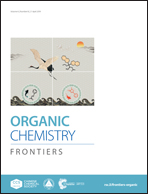Abstract
Two constitutionally isomeric chiral bis(pyridine) ligands based on planar chiral 4,15-difunctionalized [2.2]paracyclophanes were synthesized, the respective enantiomers were separated via HPLC on a chiral stationary phase, and their self-assembly behaviour upon coordination to palladium(II) ions was studied with regard to chiral self-sorting effects. As proven by NMR spectroscopy, mass spectrometry, CD spectroscopy, UV-Vis spectroscopy and X-ray crystallography both ligands form the expected dinuclear complexes upon coordination to cis-protected di- or tetravalent palladium(II) ions, respectively, however, with distinct differences concerning their chiral self-sorting ability.
![Graphical abstract: Chiral self-sorting behaviour of [2.2]paracyclophane-based bis(pyridine) ligands](/en/Image/Get?imageInfo.ImageType=GA&imageInfo.ImageIdentifier.ManuscriptID=C9QO00155G&imageInfo.ImageIdentifier.Year=2019)
- This article is part of the themed collection: In celebration of Julius Rebek’s 75th Birthday


 Please wait while we load your content...
Please wait while we load your content...